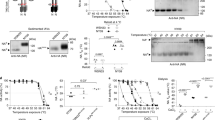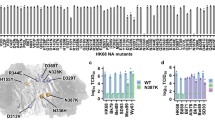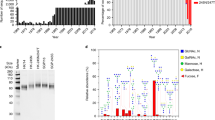Abstract
Influenza A virus neuraminidase can be classified into groups 1 and 2 on the basis of its primary structure. The main structural feature of group 1 neuraminidase is an extra cavity in the active site, the 150-cavity. Here we present the crystal structure of neuraminidase from the 2009 pandemic H1N1 influenza strain. In contrast to other characterized N1 neuraminidases, which are all members of group 1, 2009 H1N1 neuraminidase does not have a 150-cavity.
Similar content being viewed by others
Main
There have been three severe influenza pandemics: the 1918 Spanish flu, the 1957 Asian flu and the 1968 Hong Kong flu1,2. The 2009 H1N1 influenza pandemic has caused panic and controversy3,4. Recent work by our laboratory and others shows that the hemagglutinin of the 2009 swine-origin influenza A virus (S-OIV) H1N1 is very similar to the hemagglutinin of the 1918 Spanish influenza virus with regard to antigenicity, lack of N-glycosylation sites in the receptor-binding proximal region and overall structure5,6,7,8. Here we set out to characterize the second surface envelope protein, neuraminidase, from this 2009 pandemic influenza strain.
Neuraminidase is a sialidase that facilitates release of progeny virions from infected cells and prevents their self-aggregation. This process is mediated by the catalytic site located in the neuraminidase head region, which cleaves terminal sialic acid from glycosylated receptors9. There are nine serotypes of neuraminidase, named N1–N9, which are classified into two phylogenetic groups based on sequence analysis (Fig. 1): N1, N4, N5 and N8 are in group 1, whereas N2, N3, N6, N7 and N9 are in group 2 (ref. 10). The crystal structures of the globular-head regions of N1, N2, N4, N6, N8 and N9 and influenza B virus neuraminidases have been solved, in all cases showing a homotetramer with an active site that is highly conserved among all serotypes of influenza A and influenza B viruses10. On the basis of these structures, drugs such as zanamivir and oseltamivir have been developed and marketed for both therapeutic and prophylactic purposes, in a successful example of structure-based drug design11. A comparative analysis of the available neuraminidase crystal structures recently concluded that an extra cavity in the active site, named the 150-cavity, is characteristic of group 1 neuraminidases10,12. All known influenza neuraminidases contain a 150-loop that includes residues 147–152 (N2 numbering) and may be in one of two conformations: an open conformation, which leads to formation of the 150-cavity, or a closed conformation, which leads to an active site lacking a 150-cavity. Until now, all group 1 neuraminidases have been reported as having an open conformation and all group 2 neuraminidases have been reported as having a closed conformation10,12,13. The 150-cavity has been proposed as a new target for drug design against group 1 neuraminidases14.
(a) We applied a neighbor-joining method on representative N1–N9 sequences (Supplementary Methods). Groups 1 and 2 are shaded blue and green, respectively. (b) Human, swine (Sw) and avian origin N1 genes areblue, purple and green, respectively. Black asterisks, structures solved for designated subtype or strain; purple asterisks, structure solved in this study. This shows that 09N1 is a member of group 1 by phylogeny, grouping together with 18N1 and VN04N1.
Earlier phylogenetic analysis has shown that the neuraminidase from the 2009 H1N1 influenza virus, 09N1, is closely related to the neuraminidases of Eurasian swine isolates3. In our analysis, 09N1 seems to be a typical member of group 1 neuraminidases (Fig. 1a), clustering together with the neuraminidase from the 1918 pandemic virus (18N1) and the neuraminidase from the 2004 Vietnam H5N1 virus (VN04N1) (Fig. 1b). We expressed the soluble 09N1 globular-head domain of 09N1 (without the transmembrane and stalk regions) in a baculovirus expression system as described12 with minor modification (Supplementary Methods). We solved its crystal structure to a resolution of 1.9 Å (with Rwork and Rfree values of 0.169 and 0.196, respectively) by molecular replacement using the 18N1 structure (PDB 3BEQ) as a search model (Supplementary Table 1 and Supplementary Methods). As we expected, the overall structure shows a typical 'box-shaped' tetramer with four identical monomers, which are also observed in structures of neuraminidase from both influenza A and influenza B viruses (Supplementary Fig. 1)15.
We scrutinized the 09N1 structure and were surprised to find that the group 1–specific 150-cavity is absent (Fig. 2). Superposition of the 09N1 Cα atoms of the 150-loop (residues 147–152) with 18N1, N2 (PDB 1NN2) and N9 (PDB 7NN9) reveals r.m.s. deviations of 2.184, 0.261 and 0.145, respectively. The 09N1 150-loop closely resembles the previously reported group 2 neuraminidase structures16. We compared the sequences of all available neuraminidase structures and found that 09N1 shares an Ile149 with group 2 members, whereas N1 members typically have a Val149 (Fig. 3).
Structures of 09N1 (PDB 3NSS), 18N1 (PDB 3BEQ), VN04N1 (PDB 2HTY), influenza B (flu B) neuraminidase (B/Beijing/1/87; PDB 1NSB), N4 (PDB 2HTV), N8 (PDB 2HT5), N2 (PDB 1NN2), N6 (PDB 1V0Z) and N9 (PDB 7NN9) are in surface representation. This shows that 09N1, along with members of group 2 neuraminidases (N2, N6 and N9) have no 150-cavity but 18N1, VN04N1 and other members of group 1 (N4 and N8) have the cavity.
(a) Overview of 09N1 structure (monomer) with emphasis on 150- and 430-loops (yellow). (b) σA-weighted 2Fo – Fc electron density map for 150- and 430-loops contoured at 1σ. (c) Close-up of 09N1 150- and 430-loops (yellow) in comparison with these loops in 18N1(orange), VN04N1 (green) and N9 (magenta), showing opposite orientations for 150-loop of group 1 and group 2 neuraminidases. (d) Close-up of 09N1 150- and 430-loops (yellow) in comparison with Tokyo N2 (blue), which has a salt bridge between Asp147 and His150 (orange dotted lines; distances in Å) that keeps the N2 with a Val149 in a structure lacking the 150-cavity. (e) Sequence alignment and logo of 150- or 430-loops of all neuraminidases with known structures, showing conserved amino acids that we propose determine the structure of the 150-loop. Identical residues, dots. For the strain name, see Supplementary Methods.
Unlike 18N1 and VN04N1, 09N1 has the Ile149 side chain of the 150-loop oriented toward Pro431, with a distance of 1.87 Å between the closest hydrogen atoms of the terminal Ile149 carbon and the Cγ of Pro431 (Fig. 3). Although the van der Waals interaction between these residues is relatively weak, Ile149, which contains one more carbon than does the Val149 present in all the other available N1 structures, can be positioned much closer to Pro431. In all other group 1 structures, the 150-loop is open and Val149 is not in contact with any neighboring side chains (Fig. 3c), leaving it exposed. Although the 150-loop may occupy other conformations in solution, Ile149 can more easily exclude unfavorable interactions with water molecules and contributes to the formation of the 150 cavity–deficient active site in the 09N1 crystal structure. Furthermore, Arg430 in 09N1 is bent away from hydrophobic Ile149. Arg430 forms an electrostatic interaction with the main chain carbonyl of Glu434 from across the turn of the 430-loop (residues 429–433) in 09N1. Therefore, the 430-loop coordinates the specific 150-loop conformation (Fig. 3).
Additional electrostatic interactions seem important within the 09N1 150-loop, particularly the interaction between Arg156 and Glu119, which is also present in other 150 cavity–deficient group 2 structures10,16. Asp199 also participates in a salt bridge with Arg152 of the 150-loop of 09N1 (this is not present in other N1 structures, however, in N9 Arg152 forms a hydrogen bond with Asn199).
Through further structural and phylogenetic analyses, we found that Val149 is not specific to group 1 neuraminidases. Some N2s also have Val149, although a typical 'group 2' N2 (Rhode Island isolate) has an Ile149 (Fig. 3e). From the available N2 structures, we conclude that Tokyo and Memphis N2 isolates still cannot form the 150-cavity, even though they have Val149 (Fig. 3d). This is because Asp147 is in the 150-loop of N2 structures, whereas all the other neuraminidases with known structures contain Gly147 (Fig. 3e). Asp147 of N2 (Tokyo and Memphis) forms a salt bridge with His150, which pushes Val149 out toward the carbon chain of Lys431 and holds the 150-loop in its closed conformation (Fig. 3d). Therefore, we propose that the chemistry of Val149 or Ile149 and the amino acid environment around it, especially the 430-loop, determines the structure of the 150-cavity.
The absence of the 150-cavity in 09N1 could be caused by in vitro neuraminidase purification and crystallization procedures. However, the preparation methods of 09N1 and even the crystallization conditions are almost identical to those of 18N1 (ref. 12). We note that 09N1 (without the 150-cavity) and 18N1 (with the 150-cavity) share almost 100% sequence identity in their 150-loops, including residues flanking the loop from Leu127 to Pro162, with the exception of Ile149 or Val149. Therefore, the absence of the 150-cavity in 09N1 is most likely not due to in vitro preparation artifacts and probably represents a genuine feature of this neuraminidase, but future mutational analysis and/or more neuraminidase structures are needed to provide definitive confirmation.
The classification of neuraminidases into group 1 and group 2 with differences in the sialic acid–binding cavities led to the proposal that another generation of influenza inhibitors could be designed to use the additional 150-cavity14. However, our work on the structure of 09N1, showing that it does not present a 150-cavity, implies that neuraminidase inhibitors targeted to the 150-cavity will probably be less effective against H1N1 variants containing Ile149, as argued in a recent review15. This should be considered for future drug design.
Our results, together with recent work related to hemagglutinin structure5,6,17,18, show that the structures of both hemagglutinin and neuraminidase in the 2009 pandemic virus are distinct from their structures in the seasonal flu. Combinations of hemagglutinin and neuraminidase pairing may be related to distinct pathogenicity19. Because both hemagglutinin and neuraminidase of the 2009 pandemic virus have unusual characteristics5,6,7,8, future work should investigate whether this combination makes the 2009 pandemic virus unlike others.
Accession codes. Protein Data Bank: Coordinates and structure factors for 2009 H1N1 neuraminidase (09N1) have been deposited with accession code 3NSS.
References
Kobasa, D. et al. Nature 431, 703–707 (2004).
Tumpey, T.M. et al. Proc. Natl. Acad. Sci. USA 101, 3166–3171 (2004).
Novel Swine-Origin Influenza A (H1N1) Virus Investigation Team. N. Engl. J. Med. 360, 2605–2615 (2009).
Wang, T.T. & Palese, P. Cell 137, 983–985 (2009).
Zhang, W. et al. Protein Cell 1, 459–467 (2010).
Xu, R. et al. Science 328, 357–360 (2010).
Yang, H., Carney, P. & Stevens, J. PLoS Curr. Influenza RRN1152 (2010).
Wei, C.J. et al. Sci. Transl. Med. 2, 24ra21 (2010).
Colman, P.M. Protein Sci. 3, 1687–1696 (1994).
Russell, R.J. et al. Nature 443, 45–49 (2006).
von Itzstein, M. Nat. Rev. Drug Discov. 6, 967–974 (2007).
Xu, X., Zhu, X., Dwek, R.A., Stevens, J. & Wilson, I.A. J. Virol. 82, 10493–10501 (2008).
Luo, M. Nature 443, 37–38 (2006).
Mitrasinovic, P.M. Biophys. Chem. 140, 35–38 (2009).
Colman, P.M. Annu. Rev. Biochem. 78, 95–118 (2009).
Varghese, J.N., Laver, W.G. & Colman, P.M. Nature 303, 35–40 (1983).
Sun, Y. et al. Sci. China C Life Sci. 53, 633–642 (2010).
Gao, G.F. & Sun, Y. Sci. China C Life Sci. 53, 151–153 (2010).
Zhang, Y. et al. PLoS ONE 5, e9167 (2010).
Acknowledgements
We acknowledge assistance by the staff at Shanghai Synchrotron Radiation Facility (beamline BL17U). This work is, in part, supported by an intramural grant of the Chinese Academy of Sciences (KSCX2-YW-R-158) and by the Ministry of Science and Technology of China (973 project grants 2010CB534004 and 2011CB504703). G.F.G. is a leading principal investigator of the International Research Group of the National Natural Science Foundation of China (NSFC, grant 81021003). C.J.V. is supported by a CAS Fellowship (2009Y2BS2) and an NSFC grant (31050110126).
Author information
Authors and Affiliations
Contributions
G.F.G. and Q.L. conceived the research; Q.L. and W.Z. carried out the protein expression, purification and crystallization; J.Q. solved the crystal structure; E.F., J.S., H.L., J.W., X.L. and H.J. supplied the reagents. G.F.G., Q.L., J.Q., C.J.V., M.T., Y.S., X.L., J.C., J.H., J.Y. and D.L. carried out the data analysis; G.F.G., J.Q., Q.L., C.J.V., Y.S., and D.L. wrote the manuscript.
Corresponding author
Ethics declarations
Competing interests
The authors declare no competing financial interests.
Supplementary information
Supplementary Text and Figures
Supplementary Figure 1, Supplementary Table 1 and Supplementary Methods (PDF 1069 kb)
Rights and permissions
About this article
Cite this article
Li, Q., Qi, J., Zhang, W. et al. The 2009 pandemic H1N1 neuraminidase N1 lacks the 150-cavity in its active site. Nat Struct Mol Biol 17, 1266–1268 (2010). https://doi.org/10.1038/nsmb.1909
Received:
Accepted:
Published:
Issue Date:
DOI: https://doi.org/10.1038/nsmb.1909
This article is cited by
-
Antigenic comparison of the neuraminidases from recent influenza A vaccine viruses and 2019–2020 circulating strains
npj Vaccines (2022)
-
Structural restrictions for influenza neuraminidase activity promote adaptation and diversification
Nature Microbiology (2019)
-
Structure-aided drug development of potential neuraminidase inhibitors against pandemic H1N1 exploring alternate binding mechanism
Molecular Diversity (2019)
-
Implications of protein conformations to modifying novel inhibitor Oseltamivir for 2009 H1N1 influenza A virus by simulation and docking studies
VirusDisease (2018)
-
Topological N-glycosylation and site-specific N-glycan sulfation of influenza proteins in the highly expressed H1N1 candidate vaccines
Scientific Reports (2017)






